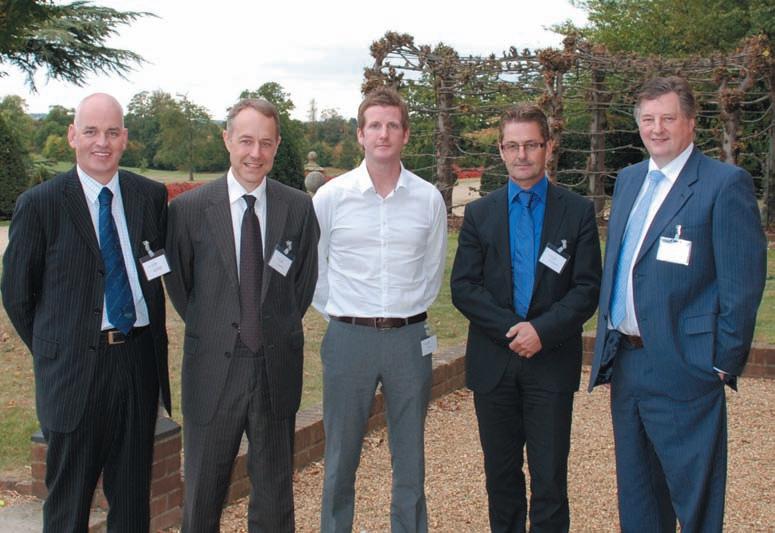
15 minute read
APEA 2009 Conference, Exhibition and Awards Dinner


Advertisement


Risk Management and Regulation in the age of retail divestment and fragmentation
By Reed Leighton, Leighton O’Brien Pty Ltd

This article explores the impact of oil company divestment and retail market fragmentation, and, possible subsequent impact on the adequacy and appropriateness of risk management based, verses prescribed standards in the downstream retail industry.
The Return on Capital at the (retail) end of the vertically integrated oil company business model is reported in the media as being poor for many years. The amount of capital required to remain the downstream retail game is immense and growing. For instance, consider the following 3 items, annual replacement cost of failed storage assets; cost of remediation; and litigation.
In terms of the cost of replacing failed storage assets, the failure rate in single walled steel systems per annum is between 0.5 % * (in a well maintained and leak monitored network) and 7%*(where leak monitoring systems are not employed and many leaks not detected). * Those numbers are based on Leighton O’Brien’s records for 15 years and 23,000 tanks currently under monitoring.
Let’s call the site annual fail rate 2%; we define the annual fail rate as leaks from tanks or lines in a given year expressed as a percentage of sites. So a global oil company could replace 2% of say 20,000 sites storage assets per annum at an average project cost of 250,000 pounds or 100 million pounds total! Anybody want to buy my network? Mmm.
Then consider environmental clean ups costs from leaks and spills across a retail network. Industry participants understand that the costs of site remediation can be extra ordinary, and when aggregated at a network level extraordinary. In some markets the environmental litigation is extreme. One oil company in Maryland, USA, is facing a class action of hundreds of millions of dollars for a leak from a line where the site had the highest

standards of equipment. Amazing what one man can do with a drill.
So it is no surprise to anyone that the global downstream oil industry has been going through profound changes in recent years. A number of major international oil companies are divesting their retail networks because of the unacceptable returns on capital, increasing demand for capital and much higher environmental risk and cost.
Whole networks of retail sites, previously owned and operated / controlled by a major oil company, are being sold off. The structures of the retail petroleum market places are varied now in the extreme and the pace of structural change will increase.
Vertically integrated oil company operated site numbers will be reduced further, hyper or super market activity may increase and I argue more independents will enter the market than leave, tied up on supply contracts by the exiting majors.
These varied market dynamics, in my view, may require a reconsideration of the best ways to affect desired safety and environmental outcomes.
To illustrate my point, imagine two separate retail petroleum market places. In the first market of 1000 sites, all the sites are owned / controlled by 5 oil companies or hyper markets. In the second scenario, every site is independently owned.
From a purely safety and environmental protection standpoint, 5 operators with 1000 sites between them have the internal expertise and resources to more than adequately assess the risks and appropriately manage these risks through centralised systems and controls. A company looking after 250 sites will have seen the problems that can arise and have an accurate perspective on how and why to manage risk well. I would go as far to write that they are very qualified and motivated to manage risk; a well managed risk is a better business outcome.
In the first market, a flexible risk based approach to safety and environmental regulation is perfectly logical, feasible and proven. Enforcement is facilitated by having only 5 stakeholders to manage; 5
stakeholders to present their risk management systems; 5 stakeholders with internal expertise and resources to control standards at 1000 sites. The regulators may even find the time for a cup of tea every now and again! Let me pose the same set of tests for the second market. Can we assume that 1000 individual operators – each one of them –would have the right knowledge set, risk management skills and resources to adequately manage safety and environment risk? 1000 operators –1000 risk management systems? All of these systems being of a sufficient quality to manage environmental and safety risk? And what of enforcement, 1000 stakeholders to manage? My point is not to argue whether a risk based or prescribed model is better, my point is that the changing structure of the down stream oil industry globally, will need to be considered to maintain the advances and high standards that our industry has achieved over the last 20 years.
APEA tel/fax 0845 603 5507 www.apea.org.uk 73

The APEA Eastern branch autumn meeting was held at Hanbury Manor near Ware in Hertfordshire on September 30th. The event was well attended. We were delighted to see members from other branches as well as Gareth Bourhill the APEA Chairman who had taken time in his busy schedule to visit us. Gareth gave an inspirational talk on the APEA as well as briefing on some of the activities it is involved in such as updating the Blue Book.
Hanbury Manor is a Jacobean Manor House set in 200 acres of Hertfordshire countryside. It was first mentioned in the Doomsday Book. It has an 18-hole golf course, which was designed by Jack Nicklaus II. The Eastern branch prides itself on finding interesting venues and topics and this was no exception covering unique futuristic and topical subjects. Our speakers were:

Attentive listeners
Phil Bloor Technical Manager E and S Environmental Limited
Phil spoke about E and S’s technologies developed to reduce water content as part of the preparation for E5 Ethanol. Effective measures have to be taken to ensure a contaminant and water-free environment. He also talked about the issue of Biofuels and bacterial growth. This posed many questions also in terms of how the sludge is later disposed of.
James Mead Head of Stakeholder Partnership Low Emission Zone (LEZ)

Gareth Bourhill, James Mead, Phil Bloor, Nico van Stavern and Anton Martiniussen
Many of you will have seen the signs as you enter London. James gave a comprehensive explanation about LEZ which is a charging scheme with the aim of reducing the pollution emission of diesel powered commercial vehicles in London. Vehicles are defined under their emissions and those that exceed predetermined levels are charged to enter Greater London. There is a planned fee introduction of a stricter regime up until 2012 when it will be fully operational. The scheme is administered by the Transport for London Executive Agency within the Greater London Authority. James talked about how the programme is
performing, what its main benefits are and how they encourage haulage companies to participate as well as their enforcement regime.
Robotic Refuelling TankPitstop
Nico. van Staveren of Stavern BV and Rotec Engineering are one of the first companies to have perfected this refuelling technology and to make it actually work in practice.
The TankPitstop is an automated fuel robot which allows motorists to refuel and pay without actually doing anything themselves.
The fuel robot will soon be able to serve 80% of cars in the Netherlands.
The robot fills the car’s fuel tank completely automatically. It recognises a car’s brand, model and type and is also equipped with a secure automated payment system. Nico also showed us some videos of the system working.
Regulator update.
This is a feature of the Eastern Branch meeting and our thanks go to Jean Fincken who despite her work load, managed to get the

Brian Doggett and Alex Boudry
update notes for the Branch meeting covering the issues of Stage II Vapour Recovery, Contractors’ recent assessment, and variations to
tank construction and prime authority partnership. Unfortunately Jean was unable to attend due to another business commitment but the details were read by the Secretary and are available on request.
Branch issues
Our Branch Representative, Adrian Holyomes
Issues raised at Eastern branch meetings have been about improved funding for branch members events and members informing about technical committees they participate in representing the APEA. This is so other interested members can connect with them. If the Branch Secretary could be made aware he can facilitate this and convey it to the executive. Comments must be precise and to the point addressing specifically any technical issues.
Next Branch meeting - For the diary
The Eastern branch early Christmas lunch will take place on Wednesday 9th December, the venue will by popular demand be held at Hanbury Manor in Ware Hertfordshire. Please contact me immediately if you would like to attend.
Scotland

As I write this report for the Bulletin, I am in the midst of liaising with our hosts at Highland Council and branch members regarding our branch meeting this Thursday in Inverness. We are looking forward to an informative and enjoyable day “up north”.
Since my last report I have been fortunate enough to have attended an excellent Technical Seminar run by Eurotank in Southampton which was very well put together.
I was also in the right place at the right time to be selected to represent the Scottish Branch at The National Conference at the Ricoh Arena in Coventry.
I am sure you will have all read in more detail how good the event was.
I would like to record our thanks to APEA at a national level for making it possible for me to attend the conference and dinner and for 3 other members to attend the evening event.
As always I was able to make contact with lots of new potential speakers!
APEA Midlands Branch AGM
Held on 7 October 2009 at the Jaguar Heritage Centre Nr Coventry.
The meeting commenced with two presentations, the first from Rodney Carter of Petroman on Stage 2 Vapour Recovery, this was followed by a presentation on the Safety Passport Alliance Scheme by Alec O’Beirne of PTF Training Ltd. A demonstration on the PETRACK tank cleaning device by Simon Palmer of First Advance Specialist Services was also made to the members.
The AGM meeting was attended by 20 members and the election of officers and committee members resulted in the following:
Chairperson TBA
Branch Secretary Peter Emery
Treasurer Bob Hurd
Branch Rep Rob Tunnicliff
Committee Members Alec O’Beirne Jeannie O’Beirne Tim Deeks Rob Tunnicliff Tom Wigfull Tom Hocking Hylton Reid Alan Fitzpatrick
Peter Emery Branch Secretary
Southern
Nothing to report
North East
Nothing to report
North West
Nothing to report
Branch Representative and Secretary Contact Details
Eastern
Adrian Holyomes - Rep HYTEK GB LTD Delta House Green Street, Elsenham Bishops Stortford, Hertfordshire Tel: 01279 815600 email: adrian@hytekgb.com
Anton Martiniussen - Sec ELAFLEX Ltd Riverside House, Hoddesdon Herts EN11 0PA Tel: 01992 452 950 Mob: 07831 595620 email: elaflex@aol.com
North East
Mike Silmon - Rep and Sec W O Silmon Ltd Industry Road, Heaton Newcastle upon Tyne Tyne & Wear NE6 5XB Tel: 0191 224 0777 Fax: 0191 224 0707 email: associationtreasurer@apea.org.uk
Midlands
Rob Tunnicliff - Rep 37 Victoria Park Road Tunstall Stoke on Trent ST6 6DX Tel: 07815 069846 email: rob.tunnicliff@stoke.gov.uk
Peter Emery - Sec Anchor Safety 19 Adonis Close Tamworth Staffordshire B79 8TY Tel: 07972 599 765 email:peter_emery@btconnect.com
North West
Louise Morgan - Rep Petrocom Ltd The Malthouse 48 Southport Road Ormskirk Lancashire L39 1QR Tel: 01695 572400 email: louisemorgan@petrocom.co.uk Bob Conlin - Sec Fairbanks Environmental Ltd The Technology Management Centre Moss Lane View Skelmersdale Lancs WN8 9TN Tel: 01695 51775 email: bobconlin@fairbanks.co.uk
Scotland
Ian Hillier - Rep North Ayrshire Council Bridgegate House Irvine KA12 8BD Tel: 01294 324969 email: ihillier@north-ayrshire.gov.uk
Paul Devine - Sec South Lanarkshire Council Consumer and Trading Standards North Stand, Cadzow Avenue Hamilton ML3 0LU Tel: 01698 476170 Fax: 01698 476180 Mobile: 07795 090903 email: paul.devine@southlanarkshire.gov.uk
Southern
Philip Monger - Rep Petrol Retailers Association Meadowside, West End, Sherbourne St John, Basingstoke, Hants. RG24 9LE. Tel: 01256 850164 Fax: 01256 851273 email: phil.monger@ukonline.co.uk
Sue Meadowcroft - Sec 1 Rock Cottage, South Cornelly Bridgend CF33 4RN Tel: 07795 841891 email: sue@high-cross.com
Ireland
Killian Tallon - Rep Topaz Energy Ltd Topaz House Beech Hill, Clonskeagh Dublin 4, Ireland Tel: + 353 1202 8705 email: killian.tallon@topazenergy.ie
Julian Rafter - Sec Olive Engineering & Design Services Ltd The Old Egg Farm Waynestown Dunboyne Meath Ireland Tel: +353 1 8253670 email: jrafter@ipservices.ie
76 APEA tel/fax 0845 603 5507 www.apea.org.uk
Petrol Filling Stations Construction, Safety and Environmental Protection
16/17 Feb Milton Keynes
20/21 April Manchester
8/9th June Dublin
9/10 Nov London
Petrol Filling Stations Risk Assessment, Audit and Inspection
6/7 April Milton Keynes
11/12 May Manchester
8/9 June Cardiff
15/16 Sep Dublin
5/6 Oct Derby
9/10 Nov Glasgow
Electrical Installations An Awareness
2 Feb Manchester
23 Feb Glasgow
30 Mar Luton
27 April Colchester
25 May Bournemouth
22 June Cardiff
21 Sept Luton
26 Oct Belfast
23 Nov Sheffield
Wetstock Management
11 May Luton
8 June Glasgow
21 Sept Manchester
Forecourt LPG Installations
18 Feb Manchester
22 April Birmingham
27 May Luton
2 Sept Milton Keynes
Explosives and Fireworks
16 Sept Luton
23 Sept Manchester
7 Oct Glasgow
12 Oct Cardiff
DSEAR 2009
9 Dec Birmingham
2010
15 April Glasgow 6 May Luton
24 June Manchester
24 Sept Derby 19 Nov Bristol
9 Dec Luton
Petrol Filling Stations –Enforcement Procedures An Awareness (One day) 6 hours Continued Professional Development
15 March Luton
5 April Milton Keynes 12 April Manchester
17 May Derby
14 June Glasgow 28 June Bristol
13 Sep Birmingham 18 Oct Cardiff
Courses will be designed around the new TCB Document, Guidance for Design, Construction, Modification, Maintenance and Decommissioning of Filling Stations.
Please contact the APEABusiness Manager on 0845 603 5507 or at admin@apea.org.uk if you wish to find out about purchasing a copy. APEAMembers can purchase the guide at the discounted rate of £40 (non member rate £120). It is strongly recommended that attendees have access to this document during courses.
All courses can be booked online at www.apea.org.uk on the ‘Training’ page. Bespoke courses can be made available provided the minimum number of Delegates is 8. This offers a discount.
For details of this and any other training enquiry, please contact: Jane Mardell - Training Coordinator, (contact details on page 3) or Brian Humm, Training Chairman Mobile: 07818 097141email: brian.humm@london-fire.gov.uk
Jamie Thompson Independent Consultant
Bob Conlin Director, Fairbanks Environmental
Brian Humm Deputy Head of Petroleum, LFEPA
Brian Baker Fire Safety & Petroleum Officer Milton Keynes Council. Gareth Bourhill Principal Training Consultant Electrical Safety Forth Valley College of Further and Higher Education
Richard Wigfull Consulting Engineer J. Wigfull & Co Ltd
Phil Lambeth Senior Engineer, BP Global Alliance Kim Bennett Senior Environmental Health Officer Milton Keynes Council
Joe Maerz Operational Manager Rural & Public Protection Team Essex Trading Standards
Jean Fincken Petroleum Inspector, LFEPA
Enforcement Procedures –An Update
By Kim Bennett, Senior Environmental Health Officer Milton Keynes Council & APEA Trainer
Those of you who have been on the Health and Safety awareness course will remember that I advocate the use of the Enforcement Management Model (EMM) to help the decision making process. The EMM is available on the HELex extranet, to which Environmental Health Officers and HSE officers have access. This is the reply I have had from Roger Marris, Chair of PELG, commenting on a reply from David Hughes of LACORS:
“As far as the HSE Extranet is concerned, (Petroleum Officers who are) licensing and building control officers, being LA employees, will [or should] have access. If they don't, this could be down to an internal policy matter.
Fire officers will only have access if their e-mail address has the '.gov.uk' suffix. For instance all the metropolitan FRSs [except West Midlands] have the '.gov.uk' suffix. I am aware that a number of FRSs
enforcing the PCA do not have the '.gov.uk', suffix so do not have access. However, they do have a conduit for information through the
CFOA PetEx Working Group. http://www.cfoa.org.uk/10038”
I have also been asking about getting the enforcement work that Petroleum Officers do, including giving support and advice, recognised by LACORS. Each year, Local Authorities report using a form known as LAE1 on the number
of premises for which they have enforcement responsibility, the number of interventions carried out
and the number of notices served
and prosecutions undertaken. At present the work of Petroleum Officers is not recognised on this form. This is Roger’s comment: “LAE1 Returns:
This has been a bone of
contention for many years. The fact that the FRSs enforcing the PCA/DSEAR and MSER are not in the loop for LAE1 returns means that enforcement action; in particular the issuing of Improvement and Prohibitions Notices goes under-recorded. This is a matter for the LAU and DCLG to
resolve.
David Hughes stated in his response that 'the decision ultimately rests with the Petroleum Enforcement Liaison Group (PELG)'. On this point, I have to disagree with David! Notwithstanding that there is a cloud hanging over the future of PELG, the concerns you have raised are for the HSE to
resolve.”
The matter has again been raised with the appropriate body, so we await the outcome.
In the meantime, anyone who has the “.gov.uk” ending to their email address should log onto Helix and download the EMM.



